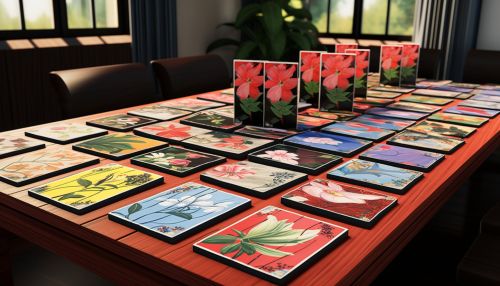Hanafuda
Introduction
Hanafuda (Japanese for "flower cards") is a traditional Japanese card game that dates back to the 16th century. The game is played with a deck of 48 cards, divided into 12 suits, each representing a month of the year and a specific flower or plant associated with that month. The game is known for its intricate artwork and complex scoring system, which requires a high level of strategy and skill.
History
Hanafuda's origins can be traced back to the introduction of playing cards to Japan by Portuguese traders in the 16th century. These early cards, known as Portuguese "tensho karuta", evolved over time into various forms of Japanese playing cards, including the hanafuda deck. The game survived periods of prohibition by the Japanese government, which viewed gambling as a social ill. In the late 19th century, the game experienced a resurgence in popularity, and it remains a popular pastime in Japan today.


Gameplay
Hanafuda is typically played by two or three players, although variations exist for larger groups. The game begins with each player being dealt a hand of cards, and the remainder of the deck is placed face-down. Players take turns drawing a card from the deck and attempting to match it with a card in their hand based on its suit. The goal of the game is to accumulate points by creating specific combinations of matched cards, known as "yaku". The player with the highest score at the end of the game is declared the winner.
Card Design
Each card in a hanafuda deck features a colorful illustration of a flower or plant associated with a specific month of the year. The artwork is highly detailed and symbolic, with certain elements indicating the card's value and potential scoring combinations. For example, cards featuring sakura (cherry blossoms) represent the month of March and are associated with the arrival of spring. The sakura cards are highly valued in the game due to their potential to form high-scoring combinations.
Variations
There are numerous variations of hanafuda, each with its own unique rules and scoring system. Some of the most popular include "Koi-Koi", "Hachi-Hachi", and "Sudaoshi". Koi-Koi is perhaps the most well-known variant, popularized in the West through various video games and anime series. In Koi-Koi, players continue to play after achieving a yaku, with the option to "call" Koi-Koi and double their points if they can form additional yaku before their opponent.
Cultural Significance
Hanafuda holds a significant place in Japanese culture and history. The game is often played during the New Year's holiday and other festive occasions, and it is also used as a tool for teaching children about traditional Japanese flora and the lunar calendar. The game's intricate artwork and symbolism reflect Japan's rich cultural heritage and appreciation for nature.
